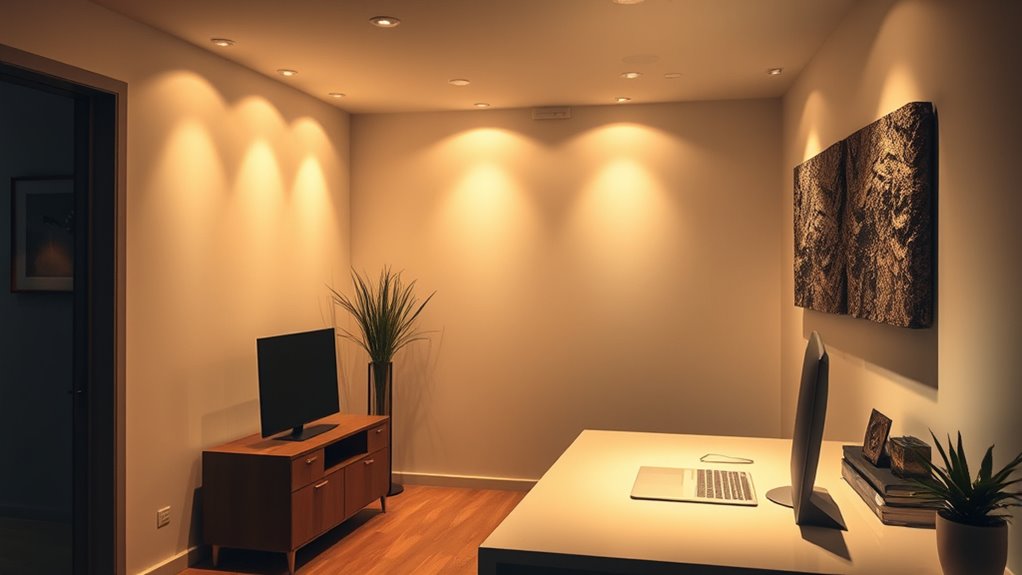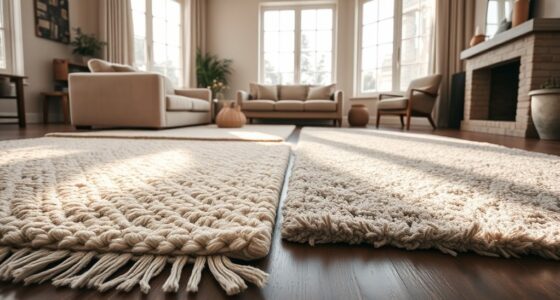To combine ambient, task, and accent lighting effectively, start with ambient lighting to set the overall mood and evenly illuminate your scene. Add task lighting to highlight specific areas or guide focus, ensuring it enhances rather than flattens the scene. Use accent lighting to create depth, emphasize textures, and separate subjects from backgrounds. Mastering these layers allows you to craft visually engaging scenes, and exploring each layer further will help you elevate your lighting design skills.
Key Takeaways
- Combining ambient, task, and accent lighting creates a balanced scene with depth and visual interest.
- Use ambient light as the foundation, then add task and accent lights to highlight specific areas and details.
- Proper layering ensures each light source serves a distinct purpose, avoiding visual clutter or flatness.
- Adjust intensity and color temperature of each layer to match the scene’s mood and storytelling goals.
- Thoughtful integration of all three layers enhances depth, focus, and overall aesthetic in photography and filmmaking.

Lighting layers are essential tools for creating balanced and dynamic scenes in photography and filmmaking. By understanding and applying layering techniques, you can control the mood, focus, and depth of your images or footage. The key is to build your lighting setup through a thoughtful lighting hierarchy, which involves arranging different types of light sources to complement each other. This hierarchy ensures that each layer serves a specific purpose and contributes to the overall visual narrative.
Mastering lighting layers through a focused hierarchy enhances your scene’s mood, depth, and visual storytelling.
The first layer, ambient lighting, provides the foundational illumination for your scene. It sets the overall tone and guarantees that your subject is visible without harsh shadows. Using natural light, softboxes, or bounce surfaces, you can create an even, gentle glow that fills the space. This layer acts as the background, establishing the scene’s mood and providing a base for additional lighting layers. When you master layering techniques, you learn how to adjust the intensity and color of ambient light to match your artistic intention.
Next comes task lighting, which is more focused and directional. It highlights specific areas or objects, guiding the viewer’s eye and emphasizing important details. For example, a key light on a person’s face or a desk lamp illuminating a workspace serve as task lights. Incorporating this layer within your lighting hierarchy ensures that your main subjects are clearly visible and stand out against the ambient background. The placement and intensity of task lighting are vital; too much can flatten the scene, while too little can make it appear dull or unbalanced.
Finally, accent lighting adds depth and dimension by emphasizing textures, shapes, and points of interest. These lights are often more dramatic and can include backlights, hair lights, or colored gels. Accent lights create visual interest and help separate your subject from the background, adding a sense of three-dimensionality. When you combine these layers effectively, you produce a scene that feels rich and layered, capturing the viewer’s attention.
An effective understanding of lighting hierarchy can also be applied to other areas, such as creating cozy atmospheres with warm tones, similar to the comforting ambiance of a wood-burning stove, which offers a sense of warmth and sustainability. Understanding the interplay between these layers, and how they fit into your lighting hierarchy, is fundamental. It allows you to craft scenes that are not only visually pleasing but also emotionally impactful. By mastering layering techniques, you gain precise control over your lighting, enabling you to sculpt your scene’s atmosphere and guide your audience’s focus effortlessly. This strategic approach transforms simple illumination into a powerful storytelling tool, elevating your photography and filmmaking to new levels.
Frequently Asked Questions
How Do I Determine the Right Balance Between Different Lighting Layers?
To find the right balance between lighting layers, you should focus on lighting contrast and fixture placement. Start by evaluating your space’s needs, then adjust each layer so they complement each other without overpowering. Place fixtures thoughtfully to highlight key areas, ensuring ambient light isn’t too harsh and accent lighting adds visual interest. Experiment with dimming options to fine-tune the balance, creating a comfortable, well-lit environment.
Can I Use Smart Lighting Systems for Layered Lighting?
Using smart lighting systems for layered lighting is like having a symphony conductor at your fingertips. You can easily adjust ambient, task, and accent lights with wireless control, creating the perfect atmosphere. Smart technology allows you to customize brightness and color, making your space more versatile. With a simple app or voice command, you can seamlessly switch between lighting layers, enhancing comfort and functionality effortlessly.
What Are the Best Bulbs for Energy-Efficient Layered Lighting?
You should choose LED bulbs for energy-efficient layered lighting because they consume less power and last longer. Look for dimmable LED options to easily adjust brightness for ambient, task, and accent lighting. CFL options are also available, but LEDs are generally more energy-efficient and environmentally friendly. Select bulbs with the right color temperature—warm for cozy spaces or cool for task areas—to enhance your layered lighting setup effectively.
How Do I Avoid Glare When Combining Multiple Lighting Layers?
Imagine a gentle breeze softly guiding your lighting, reducing glare and creating harmony. To prevent glare when combining layers, focus on lighting placement—position fixtures so direct beams stay away from eye level. Use diffusers or dimmers to soften harsh light, and aim ambient lights away from reflective surfaces. This careful balance ensures your space feels inviting, with glare reduction enhancing comfort and visual clarity effortlessly.
Are There Specific Design Styles That Benefit Most From Layered Lighting?
If you want to maximize layered lighting, modern aesthetics and contemporary design styles benefit most. You’ll find that decorative fixtures, sleek and stylish, enhance these spaces beautifully. They add visual interest while providing functional lighting. By carefully selecting fixtures that match your style, you create a cohesive look that balances ambient, task, and accent lighting. This approach elevates your space’s overall design and guarantees it stays both functional and visually appealing.
Conclusion
Think of your room’s lighting as a symphony, where ambient, task, and accent lights each play their part to create harmony. When you combine these layers thoughtfully, you craft a space that feels both functional and inviting, like a well-composed melody. Your lighting becomes more than just illumination — it transforms your environment into a vibrant, dynamic canvas. Mastering these layers lets you conduct your space with confidence, turning everyday lighting into an artful experience.









